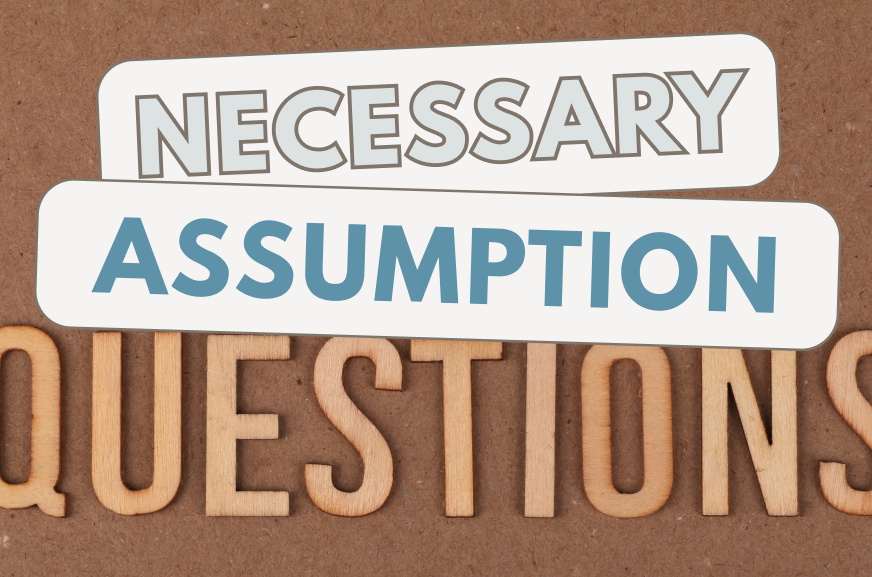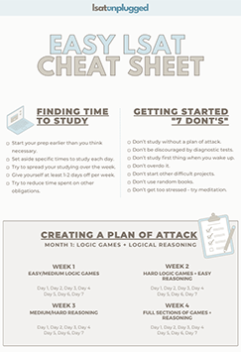In this article, I discuss a common, and effective strategy for approaching Necessary Assumption questions.
I also talk about shortcomings in the way prep companies often teach test-takers to think about necessary assumption questions.
Finally, I give some examples of necessary assumption questions and explain some frequent patterns in each.
A Common and Effective Strategy for Necessary Assumption Questions: The “Negation” / “Denial” test
As the name implies, this “test” requires you to negate each of the answer choices. The correct answer choice, when negated, renders the argument invalid. The argument cannot be valid if the necessary assumption is not true. After all, the necessary assumption is, in fact, necessary for the argument to work.
I agree with the consensus that this is a good way to approach necessary assumption questions.
How does this work in practice?
Ask yourself as you read each answer choice, does this need to be true for the evidence to require the conclusion?
Well, if it weren’t true, what would happen? Would the argument be able to coexist with the negated answer choice?
If it would not be able to, then it is the necessary assumption, so it’s our answer.
Again, the correct answer choice needs to be true in order for the argument to work. As the common question stems suggest, the argument depends upon the assumption being true, requires that it is true, and assumes that it is true.
A Quick Note on Negating Answer Choices
Make sure to translate the answer choice into its logical opposite, not its polar opposite.
Example:
The polar opposite of the statement “All people are standing” is “All people are not standing.” In English, that means “No people are standing.” It’s the other extreme. We don’t want this.
The logical opposite of the statement “All people are standing” would be, “It is not the case that all people are standing.” In English, that means “Not all people are standing” or “Some people are not standing.”
Necessary Assumption Questions Do Not Bring in New Information
Many categorization systems correctly place Must Be True questions under the umbrella of Inference questions (those asking for information we already know to be true based on the stimulus).
However, they typically categorize Necessary Assumption questions differently, placing them with Strengthen and Sufficient Assumption questions. This is a mistake. Necessary Assumptions don’t simply help the argument, and they certainly don’t bring new information to the table, as Strengthen questions and Sufficient Assumption questions do.
Necessary Assumptions are things we already know to be true based upon the stimulus.
Necessary Assumption Questions are Really Must Be True Questions in Disguise
In all the LSAT materials I’ve looked at (and I’ve looked at quite a few), the authors place Necessary Assumption questions in a separate category from Must Be True questions.
In fact, the negation test described above works precisely because Necessary Assumption questions are Must Be True questions in disguise. I proved it to you above when I plucked key words from Necessary Assumption question stems: “depends upon,” “requires,” and “assumes.” Something required to be true is something that must be true.
We could easily take any Necessary Assumption question, remove its question stem, and replace it with a Must Be True question stem, such as the following:
If all of the statements above are true, which one of the following must also be true?
Nothing would change. The Necessary Assumption question’s credited response would answer this question as well because the necessary assumption must be true if we assume the argument is valid.
Why Does the LSAT Even Have Necessary Assumption Questions?
Why not just ask Must Be True questions all the time? Why does LSAC even bother with these? What makes them different from Must Be True questions?
-Must Be True questions often involve connecting a few different pieces of information from the stimulus. (See PrepTest 29, Section 4, Question 23, p42 in Next 10, or see PrepTest 33, Section 3, Question 8 – p170 in Next 10.)
-They often involve formal logic and are simply fact sets, rather than arguments (PrepTest 30, Section 2, Question 18 – p59 in Next 10, or see PrepTest 32, Section 1, Question 7 – p120 in Next 10).
In short, they require you to make various types of connections between different pieces of information in the stimulus.
Necessary Assumption questions, on the other hand, ask for a more specific type of information that must be true. They ask for something that must be true in order for the argument itself to be valid.
Examples:
By this point, you’re probably foaming at the mouth for some examples of necessary assumption questions, so I’ve some picked out for you:
Common Necessary Assumption Question Pattern #1
PrepTest 30 (December 1999), Section 2, Questions 15 and 22 (pages 58 and 60 in Next 10, respectively)
In each of these questions, the stimulus’ argument makes the claim only one thing needs to be true for something to occur. For each of these questions, the correct answer dismisses a potential problem that might otherwise prevent the conclusion from logically following.
Common Necessary Assumption Question Pattern #2
PrepTest 37 (June 2002), Section 4, Questions 15 and 19 (pages 312 and 313 in Next 10, respectively)
In each of these questions, the stimulus’ argument mentions something new in the conclusion that was never mentioned in the evidence. They also mention something in the evidence that was never mentioned in the conclusion. As such, the new thing in the conclusion needs to be made relevant in some way for its presence in the conclusion to be justified. If it were not relevant to the evidence in any way, the argument would not be valid.
***
P.S. To be clear, I think of Necessary Assumption questions as a specific kind of must be true question – they are asking for something slightly different (an unstated / implicit premise). It’s a different question type for a reason. But I certainly wouldn’t think of them as being a type of strengthen question.
There’s still a difference in terms of approach (which is likely why they’re separate question-types).
To elaborate, what I’m saying is – what if you took that entire series of statements, i.e. the entire text of the stimulus, as given? Wouldn’t all underlying necessary assumptions need to be true?
For Necessary Assumption Qs (and Must Be True Qs), gravitate more towards moderate language – it’s more likely to be correct (supported by the stimulus) than more extreme language would be.

